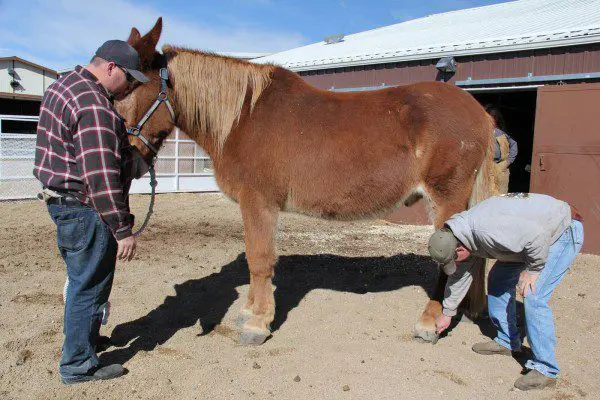What’s New with Roll? White Line Veterinarian
Roll has been coming along quite well with his White Line Disease. He has been growing a new foot at a rate of about 1/8” per week and is gaining ground. My Ranch Manager Chad had found some thrush around the frog during the morning check. He cleaned it and applied iodine to the area. However, we noticed that the lamina growing beneath the old hoof wall at the toe was beginning to curl upward. So, we contacted our veterinarian Greg Farrand to come out and take a look.
We had concerns that it would push on the old hoof wall which could put torque on the new hoof wall above and possibly cause it to begin to curl up as well. This would result in irregular hoof growth that could result in uneven pressure and an unbalanced foot. If this occurred, it would result in an imbalance throughout his entire body that could put 3000 lbs. of pressure on the damaged foot and impede our progress with him.
We went from changing the neoprene in his boot every other day to checking it twice a day to brush out any debris and to dry it off so it wouldn’t be SOAKING wet all the time.
We took off Roll’s boot and Greg began by testing the hardness of the new growth. We were concerned that it was getting a little soft with our wet spring weather after the snow had melted. It was sunny, warm and dry today, so when he tested the hardness with his little hammer, it was not as soft as we had thought a few days before.
Greg cut off the old dead lamina that was curling up and then trimmed back to healthy tissue. He did this to keep it from separating and tearing off which could possibly causing further problems.
After Greg pared off the dead curling lamina, he checked the sole growth for infection and there was none. Then he finished paring the dead lamina around the affected sole. Greg checked for a cavity between the new hoof growth and the old hoof growth to make sure everything was sound.
After paring what he did, we were left with healthy tissue and no further measures needed to be taken. He recommended that the farrier trim his heels down since he had not been trimmed since February 26th.
We are now scheduling our farrier, Dean Geesen, to come out to trim him again as soon as possible. We will continue the same protocol and be ready and flexible to promptly handle anything else that might come up in a timely fashion for the best results. Things are still looking positive.
4/7/16:
We wanted Roll to go as long as possible in between trims because we didn’t want to put too many nail holes in his damaged right hind foot. Today Dean Geesen came out and trimmed the foot after our veterinarian had the opportunity to check the foot yesterday.
Things are looking very encouraging for Roll as long as we don’t hit any serious snags. The foot is growing at a rate of 1/8” per week and is producing healthy tissue and no more separation that we can tell. We opted to get him trimmed and then just wait another month and x-ray the foot again to make sure there are no hidden issues.
We were changing the boot every other day when the weather was drier, but now we are taking off the boot and cleaning the hoof twice a day, then blowing it dry with a hair dryer to help keep out the spring moisture that was beginning to produce thrush. The trimming gave us the opportunity to trim down the heels a bit to get him backed off his toe and to re-balance the foot. We are happy with his progress so far.
Roll continues to stay sound! The key to his entire treatment has been to frequently assess the progress and then be willing to be flexible in any changes to the treatment that we might have to do. Being proactive like this is definitely the key to success in Roll’s treatment!








































































